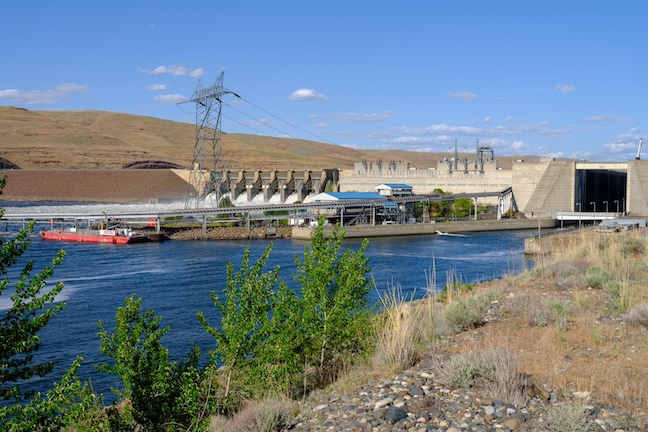forum
library
tutorial
contact

Lower Snake River Dams Closer to
Coming Down with New Agreement
by Anna V. Smith
High Country News, December 15, 2023
|
the film forum library tutorial contact |

|
Lower Snake River Dams Closer to
by Anna V. Smith
|
After decades of litigation, the historic initiative among states, tribes
and the federal government signals a dramatic change for the region.
 On Thursday, the Biden administration announced its support for preparing to breach the four Lower Snake River Dams in the Columbia River Basin through an agreement with four tribal nations, two states and several conservation groups. The U.S. Army Corps of Engineers finished building the dams in the 1970s to bolster the Pacific Northwest's hydropower and agriculture, and they have since become a primary cause of Snake River salmon declines. As a result, multiple salmon runs are veering toward extinction, and the dams have been the subject of litigation for nearly 30 years.
On Thursday, the Biden administration announced its support for preparing to breach the four Lower Snake River Dams in the Columbia River Basin through an agreement with four tribal nations, two states and several conservation groups. The U.S. Army Corps of Engineers finished building the dams in the 1970s to bolster the Pacific Northwest's hydropower and agriculture, and they have since become a primary cause of Snake River salmon declines. As a result, multiple salmon runs are veering toward extinction, and the dams have been the subject of litigation for nearly 30 years.
The agreement concludes negotiations begun under the Biden administration in 2021, to resolve the most recent lawsuit over the dams' hydropower operations. The plan itself, called the Columbia River Basin Initiative, aims to funnel more than half a billion dollars in federal funding to the region for the alternative power sources, irrigation, transportation and more that would be needed if the dams come down. Actually breaching them, however, will require an act of Congress.
The Nez Perce Tribe took part in the negotiations alongside the Warm Springs, Umatilla and Yakama nations as some of the tribes mostly deeply affected by the dams. Each tribe has long been a strong proponent of dam removal, citing salmon runs and the ongoing infringement on tribal treaty rights; the Nez Perce first passed a resolution on the subject back in 1999. Shannon Wheeler, chairman of the Nez Perce Tribe, said Thursday that the agreement would not only aid in the restoration of salmon, it was a clear sign that "we are also witnessing the restoration of tribal treaties to their rightful place under the rule of law."
The Biden administration foreshadowed yesterday's announcement in September, when it announced its support for tribally led efforts to restore salmon in the Upper Columbia with $200 million over 20 years from the Bonneville Power Administration. It also directed federal agencies to "prioritize" salmon recovery. In addition to providing funding, the new initiative commits the Department of Interior to analyze the dams' impact on tribal treaty rights and provide "a comprehensive acknowledgement from the federal government of the dams' profound negative effects on every aspect of these tribes' ways of life." In addition, the initiative signatories, which include Washington and Oregon, agreed to a pause in litigation for at least five years, and 10-year interim operating guidelines for hydropower at the dams.
Recent activity in Congress shows the political fight that any legislation to bring down the dams is likely to face. Earlier this month, House Republicans made public confidential mediation documents regarding yesterday's announcement, questioning why it was not a public process. On Tuesday, House Republicans held a Natural Resource Subcommittee on Water, Wildlife and Fisheries hearing to disparage the mediation process, which the subcommittee's chairman, Rep. Cliff Bentz, R-Ore., denounced as "backroom collusion," even though this kind of federal mediation process is typically limited to the parties involved in the litigation. Minority Vice Chair Rep. Jared Huffman, D-Calif., meanwhile, objected in the hearing that House Republicans used the committee's "time and resources in an apparent attempt to hobble settlement negotiations" instead of holding a hearing after the initiative was made public.
Many of the Republican members of Congress who represent the region that encompasses the Lower Snake River Dams have been vocal in their opposition to breaching the dams, repeatedly highlighting the possible harm to farmers, irrigators, recreationists and energy rate-payers; around 50,000 acres of farmland could be affected by dam removal. Rep. Mike Simpson, R-Idaho, is an exception: In 2021, he introduced a first-of-its-kind comprehensive plan that would remove the dams and provide enough funding, planning and public input to address any negative impacts.
Several other major dams in the Western U.S. have been demolished in the last decade. In 2014, the final dam on the Elwha River in Washington came down, and this year the largest dam removal in U.S. history, on the Klamath River in California, began with the first of four planned removals. Salmon recovery on the Elwha has been modest, but this year, the Lower Elwha Klallam Tribe was able to have a small tribal subsistence catch on a free-flowing river for the first time in 112 years. Columbia Basin tribes are hopeful that with the new initiative in place, salmon will rebound on the Snake, too. "For too long we have seen the federal government try to do the minimum amount necessary to pass legal muster," said Jonathan W. Smith Sr., the chairman of the Warm Springs Tribal Council, on Thursday. The tribe, he said, is optimistic that the agreement "will chart a new course for the federal government that will lead to true restoration of our fisheries. There is no time to waste."
learn more on topics covered in the film
see the video
read the script
learn the songs
discussion forum
